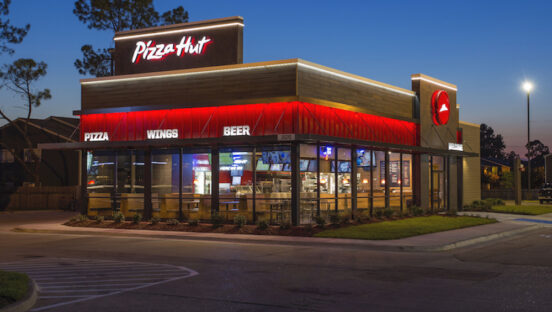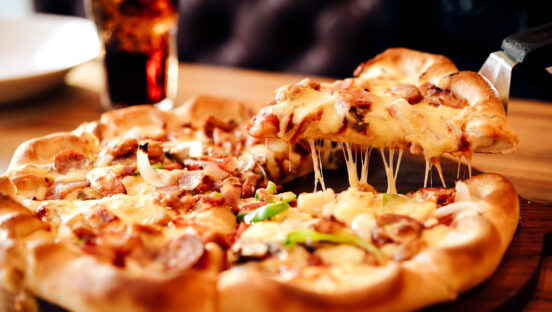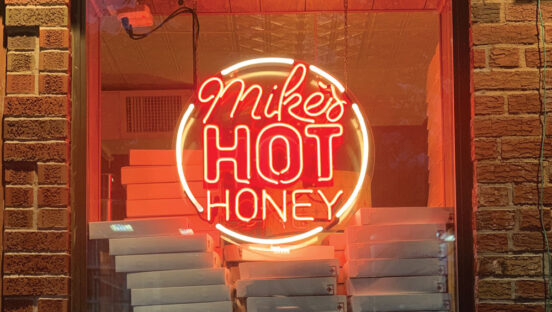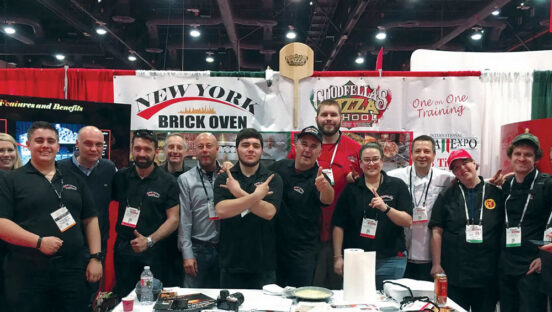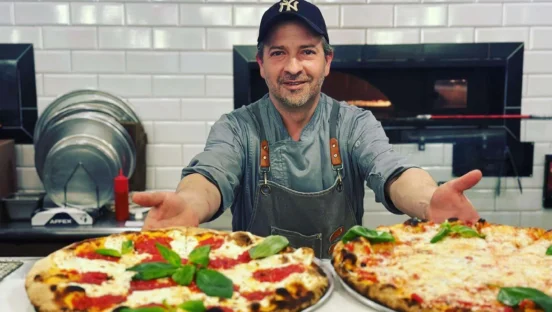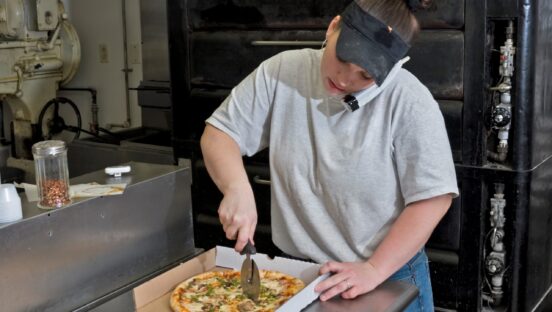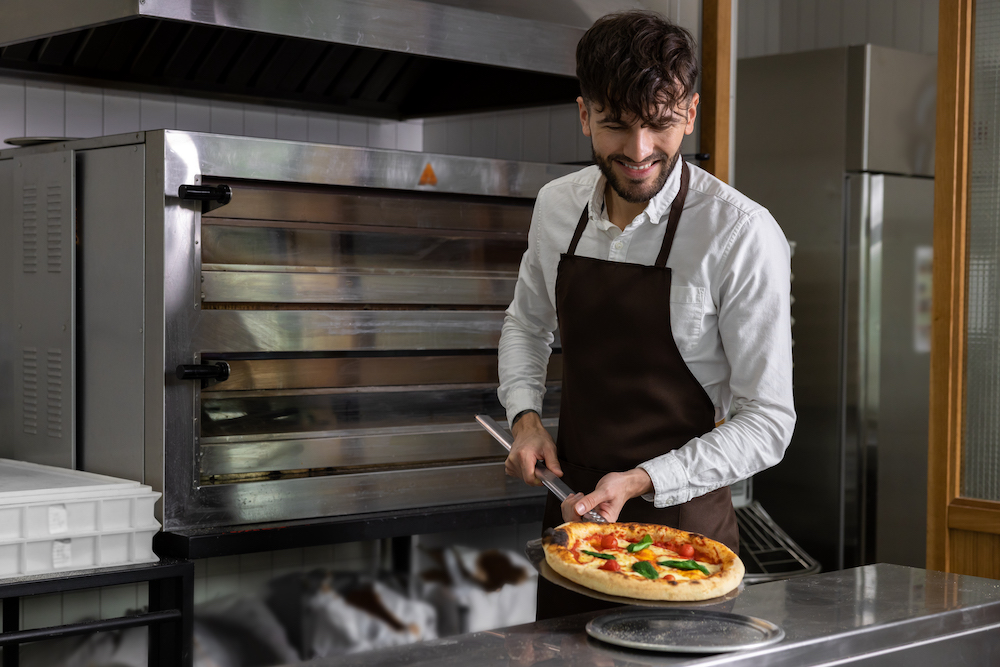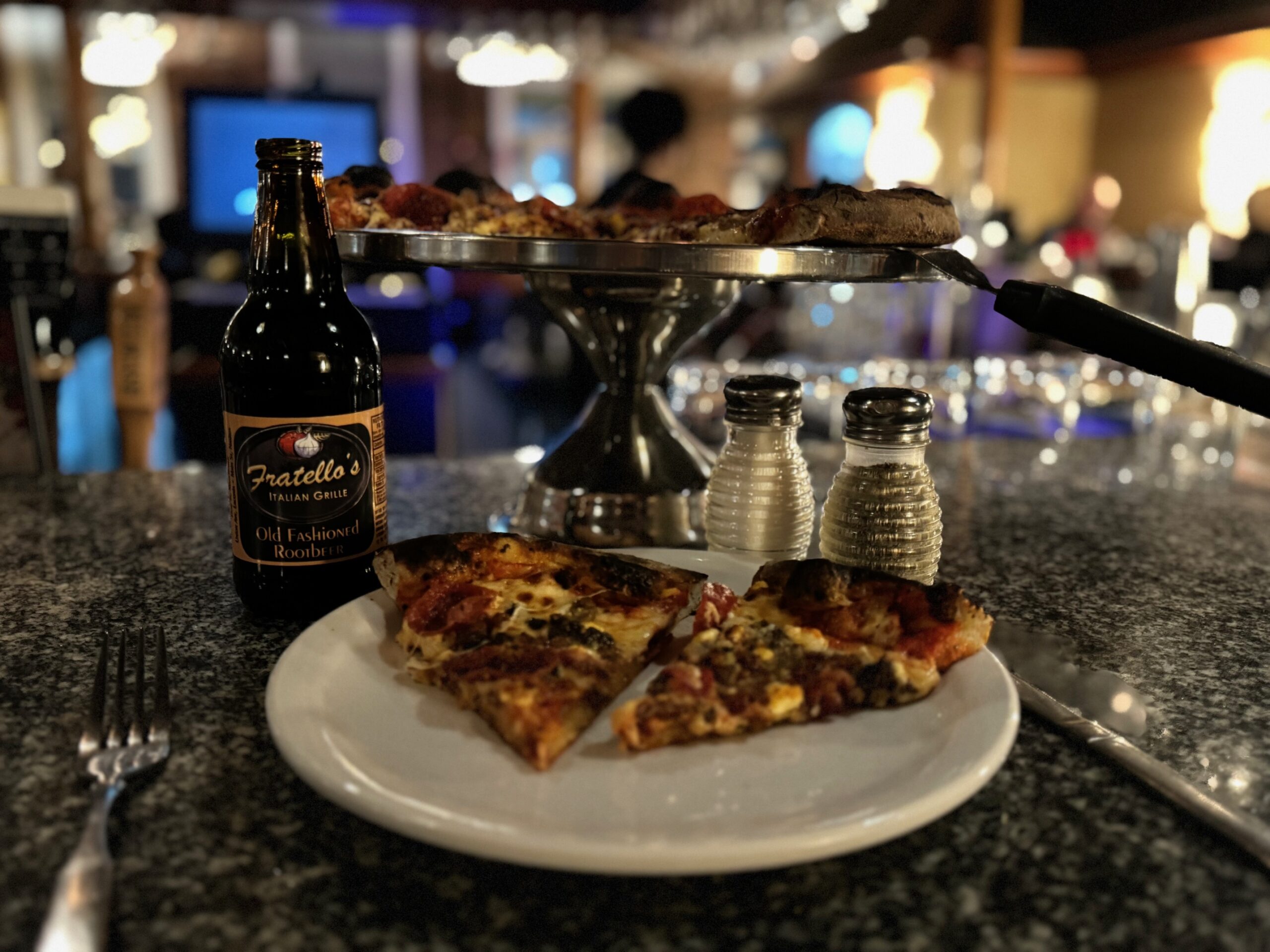So you’re ready to redesign your restaurant, you’re opening restaurant number two or you’re just getting started. How do you make sure that you set your business up in the most efficient means possible?
PMQ’s latest installment of our Info Center takes you backstage in design school to show you the ins and outs of designing (or redesigning) your restaurant.
 Back of the House
Back of the House
All restaurants can be separated into two different categories: back-of-the-house and front-of-the-house. We’ll start with the most important area for the restaurant owner—the kitchen and back-of-the-house area. Big Dave Ostrander gave me ten points to keep in mind when designing the kitchen.
1. Water source close to mixer
Big Dave’s points work under the assumption that you’re starting with a plain vanilla box. A plain vanilla box is your store with nothing in it: it only has four walls and a ceiling—not even any flooring. No flooring is a necessity for the next two tips.
If you make your own dough, install a sink with hot and cold taps within a few steps of your mixer. “You don’t want to have to push, pull or pump water more than a couple of steps,” Big Dave says. Having the sink nearby both cuts down on accidents within the work place and allows you to make dough faster and more consistently. In fact, you could install a pipe at eyelevel that taps into the hot and cold line to make getting water to your mixer even easier. If you put a scale under the outlet, zero out your scale and then fill your bucket with water, you know exactly how much water weight you’re getting.
2. Floor sinks
Most health inspectors require floor sinks. Check with your local inspector on the requirements for your town. A floor sink is basically a two-inch pipe that allows you to dump water without fear of it overflowing from the drain and are more of a precaution than anything else. The floor sinks should be carefully placed so that you can get the most use out of them, keeping in mind that you should have an air gap of about four inches. The air gap protects your sinks from sewage backing up and contaminating everything. The floor sinks are 10 to 12 inches square, relatively inexpensive and easy to drain.
3. Oven type 
One common thing that gets to most people is the placement of the oven. Do you want it to be the focal point of your restaurant or do you want to hide it in the kitchen? Not only that, but you have to decide on the type of the oven, keeping in mind the volume that you’d eventually like to be producing from the oven. One good idea is to actually ‘test drive’ the oven to check production and cook times and use that information to stop yourself from getting too much or too little oven for your restaurant. Also, in deciding where to put your oven, keep in mind the ventilation requirements and how much ventilation you’ll need. The more ventilation you need, the more expensive it gets—especially if you have to go through multiple stories.
Again, assuming that you’re starting with a plain vanilla box, make sure that you have the gas capacity that you need. If your oven and several other implements in your kitchen run off gas, you should have at least a two-inch pipe for incoming natural gas and propane. Big Dave says that he’d put in 25 percent more gas access than you currently need to leave enough room for expansion and a shut-off valve on every appliance for safety. If you have a shut-off valve on every appliance, you can turn one thing off without having to disable your entire kitchen.
4. Refrigeration room
Most people don’t have enough refrigeration or room for proper refrigeration. Keep in mind that while the size of your business may not be much now, hopefully, at some point in the future, you’ll be doing lots more business so keep that in mind when choosing a refrigerator for your needs. Lots of places don’t take into account the amount of space required for a walk-in cooler. A walk-in cooler gives you so much more refrigeration space, but if you don’t have the room for it, you might have to put it outside. If you’re leasing your pizzeria, there may be zoning problems or the building’s owner may take issue with having a walk-in outside (say in the back parking lot) of the premises. For more tips on making your refrigeration equipment last longer, check out PMQ’s equipment info center at www.pmq.com/mag/2004july_august/equipment.php.
5. Combinations of storage racks and wheels 
If you do end up with a walk-in cooler, be sure and use a combination of wire racks and rolling racks. Regardless of the type, put everything on wheels that you can (this goes for the rest of the kitchen as well). The wheels allow for easier cleaning. If something explodes in the freezer or kitchen, then you can just shift the rack and clean up. If the rack isn’t on wheels or castors, then you have to unload the rack to get to only part of the mess.
6. Two or three step kitchens
Keeping parts of the kitchen within two or three steps allows you to design for maximum efficiency. When designing your kitchen, you want your employee that’s making the pizza to be able to run the kitchen by him or herself if it’s a slow night. That means that he should be able to make it, bake it, chop it and serve it, all without taking more than three steps.
7. Flowability
Even keeping to the three-step rule, you need to keep in mind that on busy nights, no one person will be able to supply all of your pizza. So even if everything is within three steps, you need to have it so that more than one person can get in the line to help make the pizzas. Keep it so that the pizza goes from one side to the other without anyone having to pass it back and forth. “Imagine a line in the food prep area that separates the different ‘food areas’,” Big Dave says. “You don’t want anyone crossing that line into someone else’s kitchen space.” He also recommended keeping in mind a topographical look down at your kitchen to see the flow of traffic so you can avoid any collisions or potential traffic jams.
8. Wide Aisles
Most people don’t think about this particular idea: Dave recommends at least four feet for your aisles. Two feet for an aisle is often not enough, especially if you have larger people making pizza for you. What’s more, even if you don’t have larger people, two people can’t get by each other without a major hassle if the aisle isn’t big enough. Yes, you’ve designed your kitchen so that as a rule, no one has to “cross paths,” but there will be the occasional crossovers.
9. Back door access
One of the first things that you have to decide on is if your store offers delivery or not. If it will, then you need to set about adding in that service the most efficient way possible. If you do offer delivery, then make sure you can feed your drivers from the back door so that it doesn’t disrupt the front of the house operations. You should also have a holding rack for the completed pizzas so your drivers can just walk in, grab their pizzas and go.
A POS terminal by the back door is also a good idea so that the driver can use that rather than disrupting the register in the front of the store. It can also be used as a back-up POS system if the unit out front fails. If you offer drinks, you’ll need a dispenser or cooler all within easy reach of the back door. A telephone is also not a bad idea: the driver can call the customer right before they head out, confirm the order and take any last minute changes to the order.
10. High Ceilings
If you have the option, order high ceilings: at least 10 feet high. The extra height really helps to control the temperature in the kitchen portion of the restaurant since hot air rises. Also, if you hand-toss, it gives you enough room to really show off your pizza tossing skills.
Front-of-the-House
There are numerous ways to decorate your dining area. While things like the flow of your restaurant should still be taken into consideration when designing your dining area, we’ll focus mainly on the design elements that make your restaurant visually appealing. Using a variety of themes, colors, flooring and wall covering, you can create an atmosphere that is uniquely yours.

Themes:
In choosing a theme to your restaurant, there are a couple of different schools of thought in the market. The first is that the theme of your restaurant should reflect the kind of restaurant you own. For example, if you’re focusing on pizza and Italian foods, then your theme should be Italian-based. Another example is Fuel Pizza Café in Charlotte, North Carolina. Fuel Pizza makes a living selling slices in a converted gas station. The reasoning behind the name came from the location. Food (in this case, the pizza) is fuel and being in an old gas station, it only made sense to keep going. The restaurant is set up in an old fashioned, 1950’s-style diner. See the story PMQ wrote on Fuel Pizza at www.pmq.com/fuelcafe.shtml.
 The other side of the coin is to build your restaurant around one thing, related or not. For example, the Incredible Pizza Company is centered around “kid friendly” games (arcade games, bowling, go-carts and miniature golf) or Randy’s Wooster Street Pizza Shop in New Haven, Connecticut is centered around racing and cars (check out PMQ’s story on Randy’s shop at www.pmq.com/hotwheels.shtml).
The other side of the coin is to build your restaurant around one thing, related or not. For example, the Incredible Pizza Company is centered around “kid friendly” games (arcade games, bowling, go-carts and miniature golf) or Randy’s Wooster Street Pizza Shop in New Haven, Connecticut is centered around racing and cars (check out PMQ’s story on Randy’s shop at www.pmq.com/hotwheels.shtml).
Colors:
The colors in your restaurant act much like your theme. The ur restaurant act much like your theme. The coloring in your restaurant should send a message to your customers of to whom your restaurant caters. If you want a young, vibrant crowd, go with intense colors like bright blues and oranges. If you want more of a family atmosphere, try more sedate colors like darker blues or greens.
Flooring:
There is a massive variety to choose from in this section of design. You can have hard wood flooring, linoleum, industrial carpeting, tile or just plain cement, to name a few. Each has its own positives and negatives. For example, cement is great: very easy to clean and scratch resistant. However, it does make your restaurant noisy as it creates quite an echo. While carpet would fix the noise issues, you then have to deal with cleaning it. One thing to keep in mind if you decide to go with carpet is to try installing it in sections like tile. That way, if something stains the rug you can replace parts of it without having to deal with replacing the whole thing.
Wall Covering:
You can go with wallpaper, plain paint or something special. David Ianni, owner of Pazzo’s Pizza in Flower Mound, Texas decided on something special. He had a brilliant blue, Venetian plasteria to put his customers in mind of Italy. In fact, everything in his pizzeria either complements or draws your eye back to his wall, from the hand-blown glass from Morano, Italy to the photographs of Italy printed out in blue tones instead of black and white and the copper accents strategically placed around the restaurant.
Lighting:
The way you light up your restaurant can influence what your customers eat. Ever been under a florescent light? Like the way you looked? Probably not—florescent lighting is not friendly to people or food for that matter. People don’t want to eat what doesn’t look good to them. Go for warmer color temperatures, such as incandescent and halogen lights. It will give you the most bang for your buck in terms of lighting drama around your food. In fact, indirect light is better: if you have spotlights, aim and adjust your lighting so that it’s directed in the right direction.




